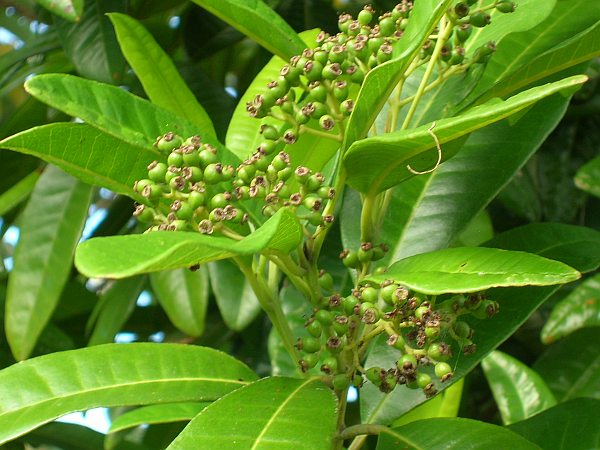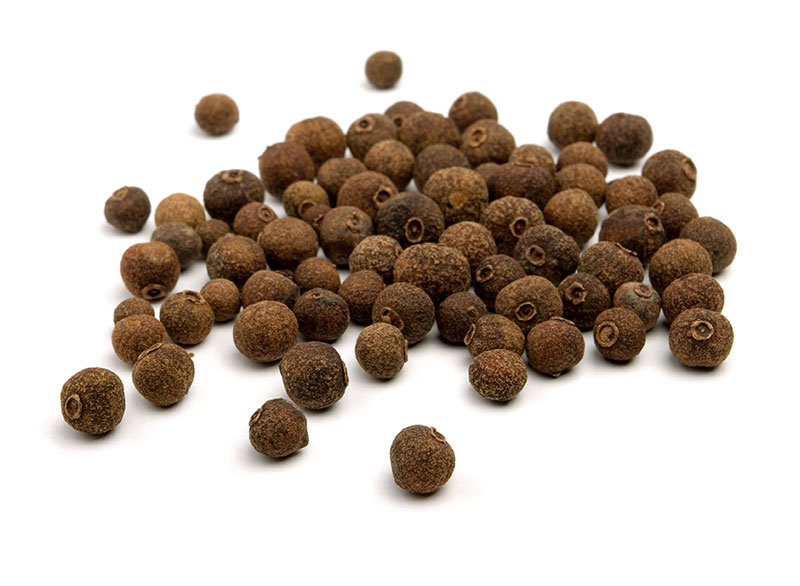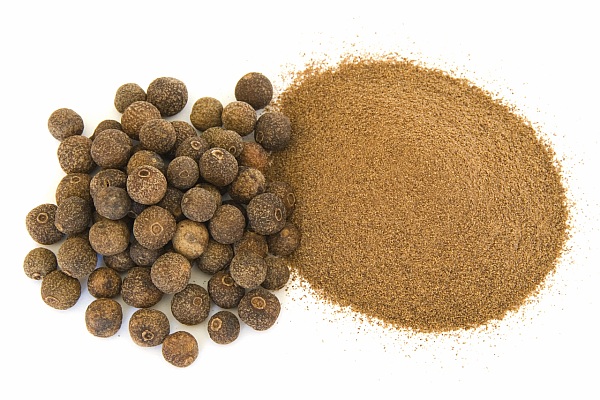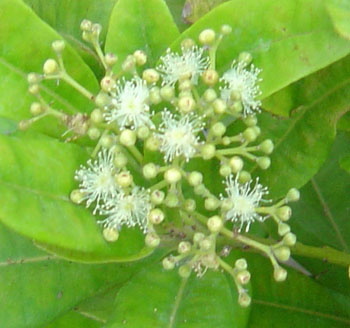Allspice
- Details
- Written by AndEl

Botanical: Pimento officinalis (LINDL.)
Family: N.O. Myrtaceae
Synonyms: Pimento. Jamaica Pepper.
Part Used: Fruit, particularly the shell.
Habitat: Pimento, or Jamaica Pepper, familiarly called Allspice, because it tastes like a combination of cloves, juniper berries, cinnamon and pepper, is the dried full-grown, but immature fruit of Pimento officinalis (Lindl.), or Eugenia Pimenta, an evergreen tree about 30 feet high, a member of the natural order Myrtaceae, indigenous to the West Indian Islands and South America, and extensively grown in Jamaica, where it flourishes best on limestone hills near the sea. In this country, it only grows as a stove plant.
It is also cultivated in Central America and surrounding states, but more than half the supply of the spice found in commerce comes from Jamaica, where the tree is so abundant as to form in the mountainous districts whole forests, which require little attention beyond clearing out undergrowth.
Description: The tree begins to fruit when three years old and is in full bearing after four years. The flowers appear in June, July and August and are quickly succeeded by the berries.
The special qualities of the fruit reside in the rind of the berries. It loses its aroma on ripening, owing to loss of volatile oil, and the berries are therefore collected as soon as they have attained their full size, in July and August, but while unripe and green.
Gathering is performed by breaking off the small twigs bearing the bunches; these are then spread out and exposed to the sun and air for some days, after which the stalks are removed and the berries are ready for packing into bags and casks for exportation.
The spice is sometimes dried in ovens (Kiln-dried Allspice), but the method by evaporation from sun-heat produces the best article, though it is tedious and somewhat hazardous, requiring about twelve days, during which the fruit must be carefully guarded against moisture, being housed at night and during rainy and damp weather.
The green colour of the fresh fruit changes on drying to reddish brown. If the fruit is allowed to ripen, it loses almost the whole of its aromatic properties, becoming fleshy sweet and of a purple-black colour. Such pimento, to render it more attractive, is then often artificially coloured with bole or brown ochre, a sophistication which may be detected by boiling for a few seconds with diluted hydrochloric acid, filtering and testing with potassium ferrocyanide; the liquid should assume at most a bluish-green colour.
The fruits as found in commerce are small nearly globular berries, about 3/10 inch in diameter, somewhat like black pepper in appearance, with a rough and brittle surface and crowned by the remains of the calyx teeth, surrounding the short style. The fruit is two-celled, each cell containing a single, kidney-shaped seed. The remains of the calyx crowning the fruit and the presence of two single-seeded cells are features that distinguish Pimento from Cubebs, the fruit of which is one-celled, one-seeded and grey and from Black Peppercorns, which are also one-celled and one-seeded.
The spice derives its name from the Portuguese pimenta, Spanish pimienta==pepper, which was given it from its resemblance to peppercorns.

Constituents: The chief constituent of Pimento is from 3 to 4.5 per cent of a volatile oil, contained in glands in the pericarp of the seeds and obtained by distillation from the fruit.
It occurs as a yellow or yellowish-red liquid, becoming gradually darker on keeping and having a pleasant aromatic odour, somewhat similar to that of oil of cloves, and a pungent, spicy taste. It has a slightly acid reaction. It is soluble in all proportions of alcohol. The specific gravity is 1.030 to 1.050. Its chief constituent is the phenol Eugenol, which is present to the extent of 60 to 75 per cent, and a sesquiterpene, the exact nature of which has not yet been ascertained. The specific gravity to some extent indicates the amount present; if lower than 1.030, it may be assumed that some eugenol has been removed, or that the oil has been adulterated with substitutes having a lower specific gravity than that of eugenol. The eugenol can be determined by shaking the oil with a solution of potassium hydroxide and measuring the residual oily layer. The United States Pharmacopoeia specifies that at least 65 per cent by volume of eugenol should be present. On shaking the oil with an equal volume of strong solution of ammonia, it should be converted into a semisolid mass of eugenol-ammonium.
The clove-like odour of the oil is doubtless due to the eugenol, but the characteristic odour is due to some other substance or substances as yet unknown. A certain amount of resin is also present, but the oil has not yet been fully investigated.
Bonastre obtained from the fruit, a volatile oil, a green fixed oil, a fatty substance in yellowish flakes, tannin, gum, resin, uncrystallizable sugar, colouring matter, malic and gallic acids, saline matter and lignin. The green fixed oil has a burning, aromatic taste of Pimento and is supposed to be the acrid principle. Upon this, together with the volatile oil, the medicinal properties of the berries depend, and as these two principles exist most in the shell, this part is the most efficient. According to Bonastre, the shell contains 1O per cent of the volatile and 8 per cent of the fixed oil; the seeds only 5 per cent of the former and 2.5 of the latter. Berzelius considered the green fixed oil of Bonastre to be a mixture of the volatile oil, resin, fixed oil and perhaps a little chlorophyll.
On incineration, the fruits yield from 2.5 to 5 per cent of ash.
They impart their flavour to water and all their virtues to alcohol. The infusion is of a brown colour and reddens litmus paper.
The leaves and bark abound in inflammable particles.

Medicinal Action and Uses: The chief use of Pimento is as a spice and condiment: the berries are added to curry powder and also to mulled wine. It is popular as a warming cordial, of a sweet odour and grateful aromatic taste.
The oil inaction resembles that of cloves, and is occasionally used in medicine and is also employed in perfuming soaps.
It was formerly official in both the British and United States Pharmacopoeias. Both Pimento Oil and Pimento Water were official in the British Pharmacopoeia of 1898, but Oil of Pimento was deleted from the British Pharmacopceia of 1914, though the Water still has a place in the British Pharmacopceia Codex.
Pimento has also been dropped from the United States Pharmacopoeia, but admitted to the National Formulary IV. Pimento is one of the ingredients in the Compound Tincture of Guaic of the National Formulary IV.
Pimento is an aromatic stimulant and carminative to the gastro-intestinal tract, resembling cloves in its action. It is employed chiefly as an addition to tonics and purgatives and as a flavouring agent.
The Essential Oil, as well as the Spirit and the distilled Water of Pimento are useful for flatulent indigestion and for hysterical paroxysms. Two or three drops of the oil on sugar are given to correct flatulence. The oil is also given on sugar and in pills to correct the griping tendencies of purgatives: it was formerly added to Syrup of Buckthorn to prevent griping.
Pimento Water (Aqua Pimentae) is used as a vehicle for stomachic and purgative medicines. It is made by taking 5 parts of bruised Pimento to 200 parts of water and distilling down to 100, the dose being 1 to 2 fluid ounces.
Concentrated Pimento Water of the British Pharmacopoeia Codex
- Oil of Pimento 1 fl. oz.
- Alcohol 12 fl. oz.
- Purified Talc 1 oz.
- Distilled Water up to 20 fl. oz.
Dissolve the oil in the alcohol, contained in a suitable bottle, add the water gradually shaking after each addition; add the talc shake, allow to stand for a few hours, occasionally shaking, and filter.
One part of this solution corresponds to about 40 parts of Pimento Water.
Other Preparations: The powdered fruit: dose, 10 to 30 grains. Fluid extract: dose, 1/2 to 1 drachm. Oil: dose, 2 to 5 drops.
Pimento is one of the ingredients of Spice Plaster. An extract made from the crushed berries by boiling them down to a thick liquor is, when spread on linen, a capital stimulating plaster for neuralgic or rheumatic pains.
The fruits of four other species of the genus Pimento, found in Venezuela, Guiana and the West Indies, are employed in their native countries as spices.
The 'Bay Rum,' used as a toilet article, is a tincture scented with the oil of the leaves of an allied species, P. acris, commonly known as the Bayberry tree.

Adulterations: Although ground Pimento is sometimes used to adulterate powdered cloves, it is itself little subject to adulteration in the entire condition, though the ground article for household consumption as a spice is subject to the same adulteration as other similar substances, it is sometimes adulterated with the larger and less aromatic berries of the Mexican Myrtus Tobasco, Mocino called Pimienta de Tabasco.
At one time the fruit of the common American Spice Bush, 'Benzoin ' was used for this purpose. The powdered berries of this American plant, a member of the natural order Lauracece, Lindera Benzoin, occurring in damp woods throughout the Eastern and Central States, were used during the War of Independence by the Americans as a substitute for Allspice and its leaves as a substitute for tea, hence the plant was often called 'Wild Allspice.' All parts of the shrub have a spicy, agreeable flavour, which is strongest in the bark and berries. The leaves and berries are also used in decoction in domestic practice as a febrifuge and are considered to have tonic and also anthelmintic properties. A tincture prepared from the fresh young twigs before the buds have burst in the spring, is still used in homoeopathy, but no preparation is employed officially.
The 'Carolina Allspice,' or Sweet Bush (Calycanthis foridus, Lindl), is a shrub 6 to 8 feet high, which inhabits the low, shady woods along the mountains of Georgia and North Carolina and in Tennessee. The whole plant is aromatic, having the odour of strawberries when crushed.
It is asserted that the shrub is important as a source of poisoning to cattle and sheep. The alkaloid it contains exercises a powerfully depressant action upon the heart.
It has been used as an antiperiodic, in fluid extract.
Liked this article? Dive deeper into personal growth and wellness! Check out CrystalWind.ca for spiritual wisdom or explore AromaWorx.ca for natural well-being tips. Spread the positivity—share this with friends on their happiness journey!
Let’s Chat! Drop Your Thoughts Below! ![]()
Disclaimer Health
All post and information provided within this blog is for educational and informational purposes only, and is not to be construed as medical advice or instruction. No action should be taken solely on the contents of this website. Please consult with your healthcare professional before making any dietary or lifestyle changes or taking supplements that may interfere with medications. Any products or information discussed are not intended to diagnose, prevent, treat or cure any illness, disease or lifestyle. Please consult your physician or a qualified health professional on any matters regarding your health and wellbeing or on any opinions expressed within this website.
Latest Articles

Imagine a world of inspiration and healing, free for all—made possible by YOU!
Donate Now—Ignite the Magic at CrystalWind.ca!

Epilepsy - Finding A Cure
Your donation can make a difference!
Help us find a cure – donate now!
Unlock Your Light: Join Lightworkers Worldwide on CrystalWind.ca!
Follow Us!
Featured This Month
Sun in Cancer
Cancer Sun Sign Characteristics Overview The name "Cancer" comes from Latin, ... Read more
Chalcedony
The Stone Of Orators Chalcedony was very popular as a decorative stone in ant... Read more
Cancer Mythology
The Mythology of Cancer: A Celestial Tale of Loyalty and Sacrifice Among th... Read more
Lammas by The Hedgewitch
Although in the heat of a Mid-western summer it might be difficult to discer... Read more
Egyptian Zodiac/Astrology
Egyptian astrology was one of the earliest forms of astrology. The Egyptians w... Read more
Abalone Shell
Echos Of The Ancestors Abalone strengthens the structure of the body and th... Read more
Lugh - Celtic God Of The Sun
The god Lugh was worshiped in Ireland as a deity of the sun. This connection... Read more































































































































































